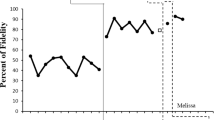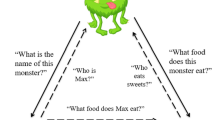Abstract
We used a delayed non-concurrent pre- and post-intervention probe design to test the effects of a voice conditioning protocol (VCP) with 3 preschoolers with autism on (a) rate of acquisition of listener curricular objectives, (b) observing voices and the presence of adults across 3 settings, (c) selecting to listen to adults tell stories in free play setting, and (d) the occurrence of stereotypy in the story setting. The VCP conditioned voices as reinforcers for listening to recordings of voices via stimulus-stimulus pairing, which resulted in the children listening to audio recordings of voices in 90% of intervals in 5-min concurrent-operant preference tests. After voices became conditioned reinforcers, all 3 children’s learning accelerated; 2 children’s observing responses increased in the 3 settings; and 2 children selected to listen to stories and also showed decreased stereotypy in the story setting. The data suggest that conditioned reinforcement for observing responses may be a verbal behavior developmental cusp that acts to accelerate learning that involves listening, and that the cusp may be induced using the VCP.
Similar content being viewed by others
References
Albers, A., & Greer, R. D. (1991). Is the three term contingency trial a predictor of effective instruction? Journal of Behavioral Education, 1, 337–354.
Bahadourian, A. J., Tarn, K. Y., Greer, R. D., & Rousseau, M. K. (2006). The effects of learn units on the student performance in two college courses. International Journal of Behavioral and Consultation Therapy, 246–265. Retrieved from http://www.ijbct.com.
Bayley, N. (1993). Bayley scales of infant development second edition. San Antonio, TX: The Psychological Corporation.
Bijou, S. W., & Baer, D. M. (1965). Child development. Vol. 2. New York: Apple-ton-Cenrury-Crofts.
Clevenger T. M., & Graff, R. B. (2005). Assessing object-to-picture and picture-to-object matching as prerequisite skills for pictorial preference assessments. Journal of Applied Behavior Analysis, 38, 543–547.
Crystal, D. (2006). How language works: How babies babble, words change meaning, and language lives or dies. Woodstock, NY: Overlook Press.
DeCasper, A. J., & Spence, M. J. (1987). Prenatal maternal speech influences on newborn’s perception of speech sounds. Infant Behavior and Development, 2, 133–150.
DeLeon, I. G., Fisher, W. W., Carter, V. R., Maglieri, K., Herman, K., & Marhefka, J. (2001). Examination of relative reinforcement effects of stimuli identified through pretreatment and daily brief preference assessments. Journal of Applied Behavior Analysis, 34, 463–473.
Dinsmoor, J. A. (1983). Observing and conditioned reinforcement. Behavioral and Brain Sciences, 6, 693–728.
Emurian, H. H., Hu, X., Wang, J., & Durham, D. (2000). Learning JAVA: A programmed instruction approach using applets. Computers in Human Behavior, 16, 395–422.
Greer, R. D. (1980). Design for music learning. New York, NY: Teachers College Press.
Greer, R. D. (1981). An operant approach to motivation and affect: Ten years of research in music learning. Documentary report of the Ann Arbor Symposium on Psychology and the Teaching and Learning of Music. Reston, VA: Music Educators National Conference.
Greer, R. D. (1994). The measure of a teacher. In R. Gardner III, D. M. Sainato, J. O. Cooper, T. E. Heron, W. L. Heward, J. W. Eshleman, & T. A. Grossi (Eds.), Behavior analysis in education: Focus on measurably superior instruction (pp. 161–171). Pacific Groves, CA: Brooks/Cole.
Greer, R. D. (2002). Designing teaching strategies: An applied behavior analysis system approach. New York: Academic Press.
Greer, R. D., Becker, B., Saxe, C. D., & Mirabella, R. F. (1985). Conditioning histories and setting stimuli controlling engagement in stereotypy or toy play. Analysis and Intervention in Developmental Disabilities, 5, 269–284.
Greer, R. D., Chavez-Brown, M. Nirgudkar, A. S., Stolfi, L., & Rivera-Valdes, C. (2005). Acquisition of fluent listener responses and the educational advancement of young children with autism and severe language delays. European Journal of Behavior Analysis, 6 (2), 125–144.
Greer, R. D., Dorow, L., & Hanser, S. B. (1973). Music discrimination training and the music selection behavior of nursery and primary level children. Bulletin of the Council for Research in Music Education, 35, 30–43.
Greer, R., Dorow, L., Wachhaus, G. & White, E. (1973). Adult approval and students music selection behavior. Journal of Research in Music Education, 21, 345–354.
Greer, R. D., & Keohane, D. D. (2005). The evolution of verbal behavior in children. Behavioral Development Bulletin, 1, 31–47.
Greer, R. D., Keohane, D. D., & Healy, O. (2002). Quality and comprehensive applications of behavior analysis to schooling. The Behavior Analyst Today, 3, 120–132.
Greer, R. D., & McCorkle, N. P. (2003). CABAS curriculum and inventory of repertoires for children from preschool through kindergarten, 3rd edition. Yon-kers, NY: CABAS/Fred S. Keller School.
Greer, R. D., & McDonough, S. (1999). Is the learn unit the fundamental measure of pedagogy? The Behavior Analyst, 20, 5–16.
Greer, R. D., & Ross, D. E. (2008). Verbal behavior analysis: Inducing and expanding complex communication in children with severe language delays. Boston, MA: Allyn & Bacon.
Greer, R. D., & Speckman, J. M. (2009). The integration of speaker and listener responses: A theory of the development of verbal behavior. Psychological Record, 59(3), 449–488.
Greer, R. D., Stolfi, L., & Pistoljevic, N. (2007). Emergence of naming in preschoolers: A comparison of multiple and single exemplar instruction. European Journal of Behavior Analysis, 8, 119–131.
Hanley, G. P., Iwata, B. A., Roscoe, E. M., Thompson, R. H, & Lindberg, J. S. (2003). Response-restriction analysis: II. Alteration of activity preferences. Journal of Applied Behavior Analysis, 36, 59–76.
Hanley, G. P., Tiger, J. H., Ingvarsson, E. T., & Cammilleri, A. P. (2009). Influencing preschoolers’ free-play activity preferences: An evaluation of satiation and embedded reinforcement. Journal of Applied Behavior Analysis’ 42, 33–41.
Hart B. M., & Risley, T. R. (1995). Meaningful differences in the everyday life of America’s children. Baltimore, MD: Paul Brookes.
Holland, J. G. (1958). Human vigilance. Science, 128, 61–67.
Home, R. D., & Baer, D. M. (1978). Multiple probe technique: A variation of the multiple baseline. Journal of Applied Behavior Analysis, 11, 189–196.
Home, P. J., & Lowe, C. F. (1996). On the origins of naming and other symbolic behavior. Journal of the Experimental Analysis of Behavior, 65, 185–241.
Ingham, P., & Greer, R. D. (1992). Changes in student and teacher responses in observed and generalized settings as function of supervisor observations of teachers. Journal of Applied Behavior Analysis, 25, 153–164.
Keohane, D., Luke, N., & Greer, R. D. (2008). The things we care to see: The effects of the rotated protocol immersion on the emergence of early observing responses. Journal of Early and Intensive Behavioral Interventions, 5(1), 23–39.
Keohane, D., Pereira-Delgado, J., & Greer, R. D. (2009). Observing responses: Foundations of higher order verbal operants. In Y. Barnes-Holmes and R. A. Rehfeldt (Eds.), Applications of Relational Frame Theory (pp. 35–76). Los Angeles, CA: Harbringer Press.
Lamm, N., & Greer, R. D. (1991). A systematic replication and a comparative analysis of CABAS. Journal of Behavioral Education, 1, 427–444.
Lodhi, S., & Greer, R. D. (1989). The speaker as listener. Journal of the Experimental Analysis of Behavior, 51, 353–360.
Longano, J., & Greer, R. D. (2006). The effects of a stimulus-stimulus pairing procedure on the acquisition of conditioned reinforcement for observing and manipulating stimuli by young children with autism. Journal of Early and Intensive Behavior Interventions, 3(1), 135–150.
Miguel, C. F., Carr, J. E., & Michael, J. (2002). The effects of a stimulus-stimulus pairing procedure on the verbal behavior of children diagnosed with autism. The Analysis of Verbal Behavior, 18, 3–14.
Moerk, E. L. (1990). Three-term contingency patterns in mother-child verbal interactions during first-language acquisition. Journal of the Experimental Analysis of Behavior, 54, 293–305.
Mowrer, O. H. (1954). The psychologist looks at language. American Psychologist, 9, 660–694.
Novak, G. (1996). Developmental psychology: Dynamical systems and behavior analysis. Reno, NV: Context Press.
Nuzzolo-Gomez, R., Leonard, M. A., Ortiz, E., Rivera, C. M. & Greer, R. D. (2002). Teaching children with autism to prefer books or toys over stereotypy or passivity. Journal of Positive Behavior Interventions, 4, 80–87.
Ockleford, E. M., Vince, M., Layton, C, & Reader, M. R. (1988). Responses of neonates to mothers’ and others’ voices. Early Human Development, 18, 27–36.
Paniagua, F. A., & Baer, D. M. (1982). The analysis of correspondence training as a chain reinforceable at any point. Child Development, 53, 786–798.
Pereira-Delgado, J., Greer, R. D., Speckman, J., & Goswami, A. (2009). Effects of conditioning reinforcement for print stimuli on match-to-sample responding in preschoolers. Journal of Speech Language Pathology and Applied Behavior Analysis, 3.2–3.3, 60–77.
Pistoljevic, N. (2008). The effects of multiple exemplar and intensive tact instruction on the acquisition of Naming in preschoolers diagnosed with autism and other language delays. (Unpublished doctoral dissertation) Columbia University, New York.
Pistoljevic, N, & Greer, R. D. (2006). The effects of daily intensive tact instruction on preschool students’ emission of pure tacts and mands in non-instructional settings. Journal of Early and Intensive Behavioral Intervention, 3(1), 103–119.
Roane, H. S., Vollmer, T. R., Ringdahl, J. E., & Marcus, B. A. (1998). Evaluation of a brief stimulus preference assessment. Journal of Applied Behavior Analysis, 31, 605–620.
Rosales-Ruiz, J., & Baer, D. M. (1996). A behavior-analytic view of development. In E. Ribes & S. W. Bijou (Eds.), Recent approaches to behavioral development (pp. 155–180). Reno, NV: Context Press.
Schlinger, H. D. (1995). A behavior analytic view of child development. New York: Plenum.
Selinske, J. E., Greer, R. D., & Lodhi, S. (1991). A functional analysis of the comprehensive application of behavior analysis to schooling. Journal of Applied Behavior Analysis, 24, 107–117.
Skinner, B. F. (1957). Verbal behavior. Acton, MA: Copley Publishing Group and the B. F. Skinner Foundation.
Sparrow, S. S., Balla, D. A., & Cicchetti, D. V. (1984). The Vineland Adaptive Behavior Scales. Circle Pines, MN: America Guidance Service.
Sundberg, M. L., Michael, J., Partington, J. W., & Sundberg, C. A. (1996). The role of automatic reinforcement in early language acquisition. The Analysis of Verbal Behavior, IS, 21–37.
Tsai, H., & Greer, R. D. (2006). Conditioned preference for books and faster acquisition of textual responses by preschool children. Journal of Early and Intensive Behavioral Interventions, 3(1), 35–60.
Vaughan, M. E., & Michael, J. L. (1982). Automatic reinforcement: An important but ignored concept. Behaviorism, 10, 101–112.
Waddington, E. M., & Reed, P. (2009). The impact of using the “Preschool Inventory of Repertoires for Kindergarten” (PIRK® on school outcomes on children with autism spectrum disorders. Research in Autism Disorders, 3, 809–827.
Williams, B. A. (1994). Conditioned reinforcement: Neglected or outmoded explanatory construct? Psychonomic Bulletin and Review, 1(4), 457–475.
Yoon, S. Y. (1998). Effects of an adult’s vocal sound paired with a reinforcing event on the subsequent acquisition of mand functions. (Doctoral dissertation, Columbia University, 1998). Abstract from UMI Proquest Digital Dissertations. (Dissertations Abstracts Item: AAT 9839031).
Yoon, S. Y., & Bennett, G. (2000). Effects of a stimulus-stimulus pairing procedure on conditioning vocal sounds as reinforcers. The Analysis of Verbal Behavior, 17, 75–88.
Zimmerman, I. L., Steiner, V. G., & Pond, R. E. (2002). Preschool language scale–4. San Antonio, TX: Harcourt Assessment.
Author information
Authors and Affiliations
Corresponding author
Rights and permissions
About this article
Cite this article
Greer, R.D., Pistoljevic, N., Cahill, C. et al. Effects of Conditioning Voices as Reinforcers for Listener Responses on Rate of Learning, Awareness, and Preferences for Listening to Stories in Preschoolers With Autism. Analysis Verbal Behav 27, 103–124 (2011). https://doi.org/10.1007/BF03393095
Published:
Issue Date:
DOI: https://doi.org/10.1007/BF03393095




